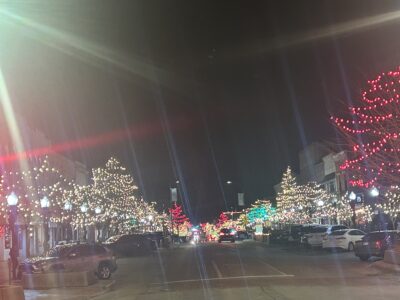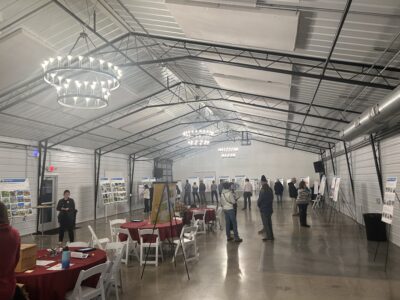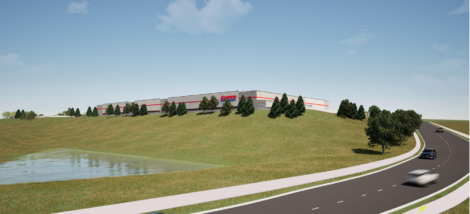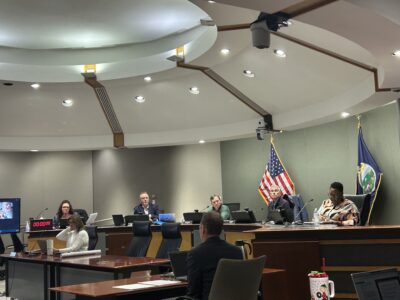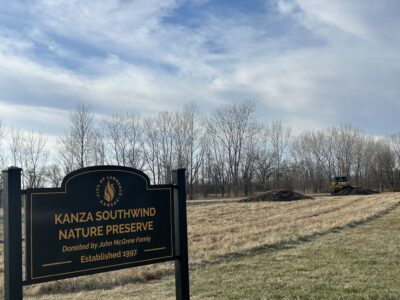As Lawrence works on its updated Land Development Code, some neighbors near KU’s campus are worried by proposed changes to housing density

photo by: Bremen Keasey
The University Place neighborhood in Lawrence is pictured from Indiana Street and West 17th Street. Residents fear that changes in the draft of Lawrence's new land development code could change their neighborhood to allow more student housing to move in.
Just in terms of geography, it is easy to feel the looming presence of the University of Kansas from University Place.
The little neighborhood tucks in between the southeast corner of KU’s campus to its north and 19th Street to the south, with its west and east borders at Naismith Drive and Louisiana Street, respectively. It was originally platted as part of the city of Lawrence in 1887 and had its neighborhood organization formed in 1987 to serve the 267 households that make up a neighborhood with a mix of everything.
“It has all ages, all incomes and we’re close with each other,” said Pam Burkhead, a resident of the neighborhood.
But residents of University Place are worried that the university and its students could in some ways get a lot closer. Mandy Enfield, the president of the University Place Neighborhood Association, began digging through the draft of Lawrence’s Land Development Code. The project to update the city’s code, which has not been updated since 2006, started in 2022 and aims to establish a simpler and more consistent set of development procedures and help the city better achieve goals in its Plan 2040 strategic plan — including building more density in housing and affordable housing.
Those changes in housing density give Enfield pause about what could happen in University Place. She said she and other neighbors fear out-of-town developers will easily be able to sweep in, buy up properties and convert them into student housing and turn the neighborhood upside down — much like what previously happened to the Oread neighborhood.
“This could make it so much more lucrative for landlords, increase profit potential and outbid us even more,” Enfield said.
Some of the key changes to the code that University Place residents are concerned with are an increase in allowed occupancy; an increased allowance of multi-unit dwellings, duplexes and accessory dwelling units; and changes to the permitting process that could let developments be approved sooner.
After the first draft of the Land Development Code was released in the summer of 2024, the Planning Commission and Land Development Code Steering Committee have been meeting and making edits and tweaks to the code. In the latest edition of the code, the standard for a “household” allowed for the possibility of five unrelated people living together in one dwelling unit.
Jeff Crick, the city’s Planning and Development Services director, said in the city’s current code, there are some zoning areas that cap the number at four and others that cap it at three. But even in the places where only three unrelated occupants can live together, there are buildings that could physically house more people if the rules allowed it. Changing the code could mean that some buildings could suddenly jump from being able to house only three people to being able to house five.
The code changes also could mean the spread of more dense housing styles into University Place, leaving little elbow room in a neighborhood with smaller lots.
With the streamlining of the code, a mix of different residential zoning districts will be put into broader categories. As part of that, University Place’s designation would be something called R-2, which would allow for the development of duplexes and accessory dwelling units in the neighborhood.
Although larger multi-unit developments would not be allowed, according to the draft code, if some houses were converted to duplexes aimed at students and both parts of the duplex could house five people, Enfield said that could suddenly change the count from four people on one lot to 10.
“It’s such a massive shift,” Enfield said.
Additionally, the allowance of ADUs — a secondary housing unit on a single-family residential lot — into districts zoned R-2 creates another concern about taking up space. As University Place is currently zoned, ADUs are not able to be constructed. If they are allowed, Enfield is worried that developers could suddenly add multiple units across the neighborhood and suddenly scores of students would be “30 feet from someone’s bedroom window.”
Crick said as the draft is currently written, building an ADU on a lot would add one more allowed person to the occupancy limit. So under the draft, if a home that holds five people added an ADU on the lot, it wouldn’t be permitted to have an additional five people in the ADU. That new occupancy limit would be six, Crick said.
Additionally, an ADU has to be subordinate to a primary unit, so a developer wouldn’t be able to build a lot of ADUs, Crick said. While there are some more details to iron out in the process between the Planning Commission and LDC Steering Committee about if there are specific limits on how many people could occupy an ADU, Crick said it is something the team is mindful of.
“There’s some open-endedness on that one, but it’s definitely something we’re having conversations around,” Crick said.
Other changes in the code mean that some options for buildings will be “zoned by right,” which would allow developments to move ahead without as many planning-related hurdles in the way. That is ratcheting up the fears for Enfield and Burkhead that a developer could come in and immediately change a lot by building much more density on lots that previously only allowed for single dwellings. Enfield said that city staff did a calculation on her 14,000-square-foot lot to find the maximum density for the lot, and they found it could actually be broken up into two lots. This could mean many more buildings and units would be allowed in neighborhoods than before.
Crick acknowledged that if buildings were zoned by right, depending on the property, it could immediately go to the building permit application process as opposed to a “planning process,” which has a lot more requirements for public notices, hearings and appeals. Crick said he certainly thinks that type of change is something the committees can look to modify.
“It’s about figuring out what the community’s comfort is on that,” Crick said.
Crick noted the new draft would add in infill standards that aim to address some of the concerns about historic areas being changed. That thought meshes with Plan 2040’s goal of keeping the feel of existing neighborhoods intact, so you can see the unique architecture and features as you’re walking down the street, and Crick said it’s a brand new addition to Lawrence’s code.
“Those standards are there to help ensure if something is developing, it does try to work to meet that mark,” Crick said.
The thought of new developments coming through to the residents with little notice is something that Burkhead feels could “destroy the historic nature” of Lawrence and of University Place. Enfield said the groundbreaking changes should be eased, and suggests adding language that states changes to existing neighborhoods “have to be gradual.”
Because the code is written as a “package” and the many different chapters all lean on each other to outline the standards, Crick said it can be really difficult to roll out the code in a piecemeal approach.
The density of the code can make people’s heads swim, as Enfield can attest to as she started diving in on the research. With only a few more meetings left in the process of presenting the code for final approval — the Planning Commission has its final review on Oct. 23, the Steering Committee on Oct. 24 and the City Commission will give its first reading on Nov. 12 — Enfield wanted to get some certainty on what the code could entail.
As she asked questions of planning staff and thought of hypotheticals, she found that a common response was a feeling that this type of development is difficult, so no developer will do it. Enfield felt that was unsatisfactory.
When asked about the feasibility of the scenarios of lots being bought and chopped up, Crick said it was difficult to answer, in part because so many of those questions were dependent on the properties.
But Crick did note that even if the code gets approved, the code is not something fully set in stone. The city will look to see how development happens and that the promises of how to grow Lawrence set out in Plan 2040 are being kept, he said.
“We’re always looking at the code to make sure that it’s meeting the community’s expectations,” Crick said. “If it’s not, then we go back in and make some changes.”


